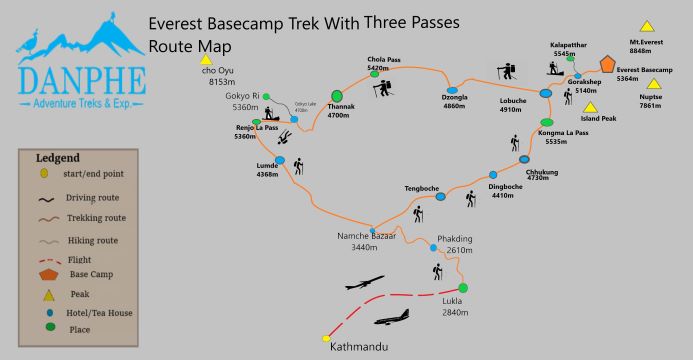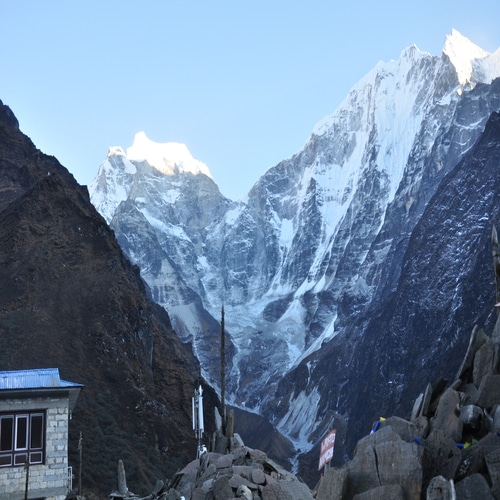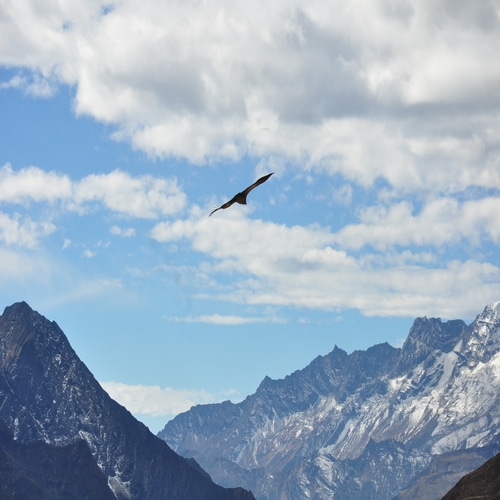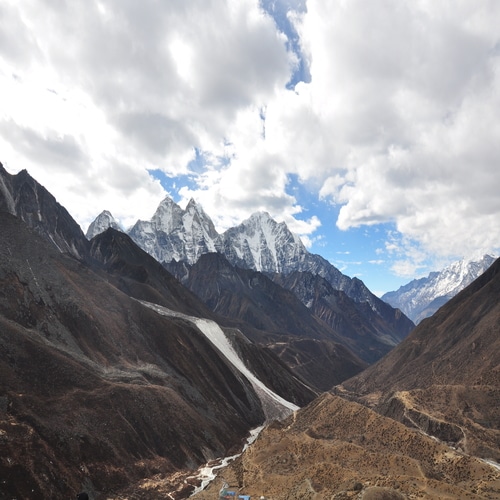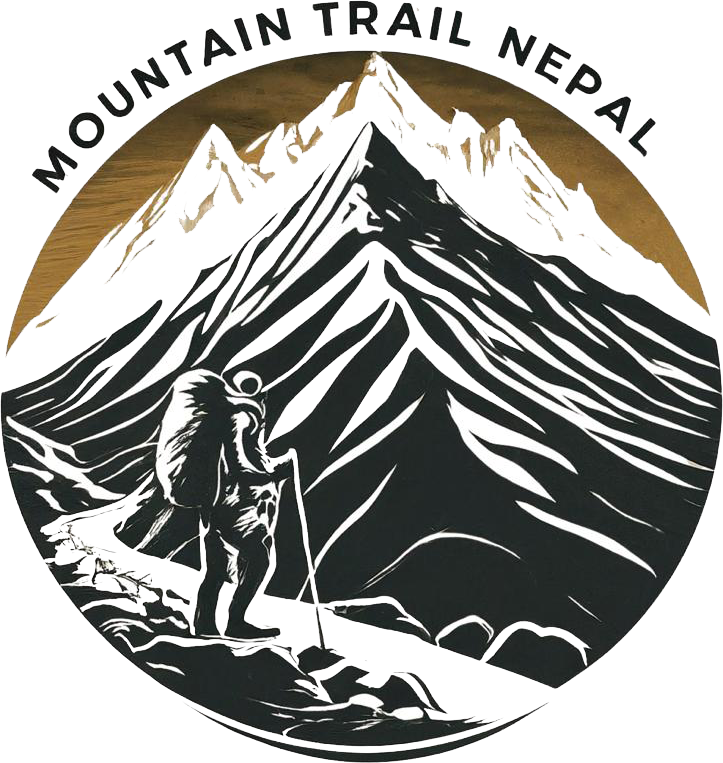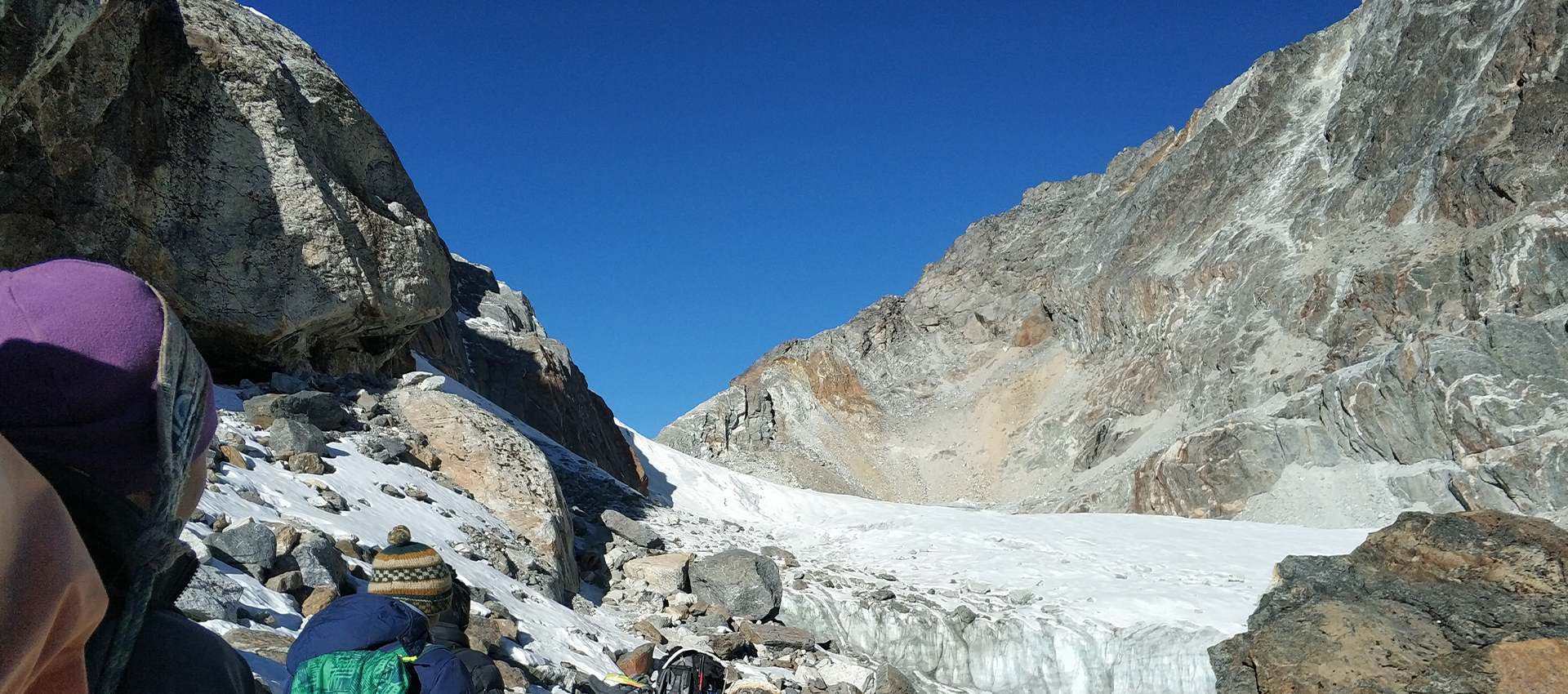Everest Three Passes Trek
Nepal offers more than just the majestic Himalayas. The Everest Base Camp with Three Passes Trek is a challenging adventure that focuses on three snowy passes: Kongma La (5535m), Renjo La (5360m), and Cho La (5420m). Along the way, you’ll marvel at breathtaking sights like Ama Dablam (6856m), Lhotse (8414m), and Mount Everest (8848m), as well as the endless blue horizon.
The journey begins with a visit to the cultural sites of the Kathmandu Valley, designated as UNESCO World Heritage Sites. Then, we take a short flight to Lukla and start trekking to Phakding. Passing through green landscapes and icy terrain, we reach the Sherpa settlement of Namche Bazaar. From there, we head to the Tengboche Monastery in Tengboche village.
Continuing along the Imja River trail, we reach Dingboche and then Chhukung. Trekking on the Nuptse glacier moraines, we conquer the Kongma La Pass (5535m) and enjoy stunning mountain views. Next, we head to Everest Base Camp via Gorakshep, where we witness breathtaking sunrises and sunsets from Kalapatthar.
Descending towards Dzongla, we then make our way to the Gokyo Lakes. Crossing the Cho La Pass (5420m) filled with Chortens, we reach the lakes and hike to Gokyo Ri (5360m) for rejuvenating views. Crossing Dudh Pokhari, we head to Renjo La Pass (5360m), then to Lumde, and finally back to Namche Bazaar. Trekking through lush forests, we return to Lukla and take a scenic flight back to Kathmandu, concluding our trip.
The Everest Base Camp with Three Passes Trek requires expert guidance, and Mountain Trail Nepal provides experienced guides who know the Khumbu region well. They’ll lead you through the landscape and share insights into the local culture along the way.
Trip Highlights
- Experience the thrill of crossing three of the highest passes in the Everest region:
- Kongma La (5535m), Renjo La (5360m), and Cho La (5420m).
- Explore the iconic Everest Base Camp (5364m) and soak in the breathtaking views of the Everest vistas, Khumbu Icefall, and Glacier.
- Catch the mesmerizing sunrise at Kalapatthar, offering panoramic views of Mount Everest (8848m) and other majestic peaks.
- Immerse yourself in the vibrant Sherpa culture and lifestyle, experiencing their traditions firsthand.
Trip Itinerary
Expand All
Shrink All
-
Day 01: Arrive in Kathmandu (1300m) and Welcome Dinner
When you arrive at Tribhuvan International Airport, our representative will be there to meet you. They will take you to your hotel. You can spend the day exploring Kathmandu Valley. In the evening, you can join the other members of the trek for a welcome dinner hosted by Danphe Adventure Treks. You’ll spend the night at the hotel in Kathmandu.
-
Day 02: Kathmandu Sightseeing, and preparation for the trek
Begin your day with a traditional Nepali breakfast. Then, embark on a tour to visit the main UNESCO World Heritage sites in the Kathmandu valley: Swayambhunath, Kathmandu Durbar Square, Pashupatinath, and Boudhanath. After exploring these sites, return to the hotel to prepare for the trek. Spend the night at the hotel in Kathmandu.
-
Day 03: Fly from Kathmandu to Lukla (40 minutes) (2850m) and trek to Phakding (2600m) 3 hrs.
Early in the morning, we board a plane and fly to Lukla, which is the starting point for our adventure in the Everest region. The flight offers stunning views of the Khumbu region. When we land in Lukla, we prepare our belongings and start our trek to Phakding. The trek involves walking on steep paths through forests. We reach Phakding by afternoon and stay there overnight.
-
Day 04: Trek from Phakding to Namche (3440m) 6 hrs
The path to the largest Sherpa village has many ups and downs. It’s a bit tough, but seeing the Dudh Koshi River and Thamserku (6608m) makes it worthwhile. We pass through Bengkar village and enter Sagarmatha National Park after getting our permits checked. Then, we walk through Jorsalle village and finally reach Namche. We’ll spend the night in Namche Bazaar.
-
Day 05: Rest/Acclimatization in Namche 3 hrs.
Today is a rest day for acclimatization. We’ll spend the day exploring the area around Namche Bazaar. We’ll walk to the Everest View Hotel to see the breathtaking views of Everest (8848m), Lhotse (8414m), and Thamserku (6608m). We’ll also visit the Khumjung monastery and the Hilary school. We’ll spend the night at Namche Bazaar.
-
Day 06: Trek from Namche to Tengboche (3860m) 5 hrs.
Today’s trek is relatively easy as we make our way to Phunki Tenga. From there, we continue on to Tengboche village, home to the largest monastery in the Everest region. We’ll explore the monastery and meet the monks who live there. The monastery offers stunning views of mountains like Everest (8848m), Ama Dablam (6856m), Thamserku (6608m), Nuptse (7861m), and Lhotse (8414m). We’ll spend the night in Tengboche.
-
Day 07: Trek from Tengboche to Dingboche (4410m) 6 hrs.
As we trek, we’ll pass through lush forests filled with birch, rhododendron, and coniferous trees. Along the way, we’ll enjoy stunning views of Ama Dablam (6856m) and Lhotse (8414m). The trail descends to Debuche before crossing the Imja River and reaching Pangboche. We’ll see the beautiful Pangboche monastery before continuing on to Dingboche, where we’ll spend the night.
-
Day 08: Trek from Dingboche to Chhukung (4730m) 2 hrs.
We stroll through fields guarded by stone walls and follow the Imja Khola valley. Along the way, we pass through Bibre, where we can spot many yaks. Ama Dablam (6856m) is easily visible from this point. As we start climbing towards Chhukung, the path becomes steep. We finally reach Chhukung, where we’ll stay for the night.
-
Day 09: Trek from Chhukung to Lobuche (4940m) via Kongma La Pass (5535m) 8 hrs
We start our trek early to reach the top of Kongma La Pass (5535m). Walking over the Nuptse glacier moraines, we make our way to the pass. At the summit, we’ll see prayer flags covered in snow. The descent from the pass is a bit tougher, so we need to be careful. We then head north, following the Khumbu glacier until we reach Lobuche, where we’ll spend the night.
-
Day 10: Trek from Lobuche to Everest base camp (5364m) via Gorakshep. Stay overnight in Gorakshep (5170m) 8 hrs
We continue along the Khumbu glacier, where we can see the northern side of Everest and other huge peaks like Pumori, Khumbutse, and Nuptse. Following a steep trail, we reach the summit of the Changri glacier, where we’re greeted by the majestic mountains at Gorakshep. After lunch, we trek to the Everest Base Camp, crossing dunes, moraines, and streams along the way. After taking in the grandeur of Mount Everest, we return to Gorakshep for the night.
-
Day 11: Morning hike from Gorakshep to Kalapatthar (5545m) 3 hrs and trek to Dzongla (4860m) 5 hrs.
The morning trek from Gorakshep to Kalapatthar is tough, but when we reach the top, we’re rewarded with stunning views of the Himalayan mountains, including Everest, Lingtren, and Khumbutse. Kalapatthar is known as one of the best spots to see Mount Everest up close, and it doesn’t disappoint. After enjoying the view, we hike back down to Dzongla, navigating the downhill path. We spend the night in Dzongla.
-
Day 12: Trek from Dzongla to Gokyo Lakes (4790m) via Cho La Pass (5420m) 8 hrs.
The path to the Chola Pass is steep and includes climbing over boulders. It’s important to be careful while ascending to the summit. Once we reach the top, we’re greeted by prayer flags and a beautiful view. The trail to Thangnak is long but rewarding, with views of the Ngozumpa glacier and the Gokyo Lakes in the distance. Gokyo village, located near the lakes, offers a peaceful retreat for the night.
-
Day 13: Rest day in Gokyo and hike up to Gokyo Ri (5360m)
Today, we took a break from trekking to help our bodies get used to the higher altitude. We climbed up to Gokyo Ri, a peak standing at 5360 meters above sea level. From there, we enjoyed breathtaking views of several towering mountains including Cho Oyu, Everest, Lhotse, Nuptse, and Makalu. We also got a glimpse of the Ngozumpa glacier. After spending some time taking in the stunning scenery, we made our way back down to Gokyo village, where we relaxed for the rest of the day. We spent the night in Gokyo village.
-
Day 14: Trek from Gokyo to Lumde (4368m) via Renjo La Pass (5360m) 7 hrs.
We continued our journey along the Dudh Pokhari and then descended towards the Renjo La Pass, which stands at 5360 meters above sea level. Along the way, we were treated to stunning views of the Rolwaling ranges. The scenery from the pass was absolutely breathtaking, and we made sure to capture some memorable moments. After descending on stone steps and passing by the Relama Tsho, we eventually reached Lumde, where we spent the night.
-
Day 15: Trek from Lumde to Namche (3440m) 6 hrs.
Leaving Lumde behind, we made our way towards Marulung, following a path that led us downhill to Thame. This route has been used by Tibetan traders for centuries. Along the way, we crossed the Bhote Koshi River and stopped to visit the Thame Monastery. Continuing our descent, we passed through several small villages before finally reaching Namche Bazaar, where we spent the night.
-
Day 16: Trek from Namche to Lukla (2840m) 6 hrs.
We followed the Dudh Koshi River, walking on a path that gradually became easier to navigate. Along the way, we passed through beautiful Rhododendron forests, where we could admire the snowy peaks in the distance. We also had the chance to experience the rich culture and traditions of the Sherpa villages we passed through. Finally, we reached Lukla, where we checked into our hotel and celebrated the success of our trek. We spent the night there before heading home.
-
Day 17: Take a flight from Lukla to Kathmandu | 1300m
We finished our Himalayan adventure by taking a flight back to Kathmandu. While flying, we enjoyed the breathtaking views of the snow-capped peaks one last time, cherishing the memories we made in the mountains. Once we landed in the valley, we were taken to our hotel in Kathmandu, where we spent the night before heading home.
-
Day 18: Spare Day (In case of Bad weather) and Farewell dinner
Today is a spare day just in case something unexpected happens, like bad weather delaying our plans. If everything goes smoothly, you can explore the local markets in Kathmandu. There, you’ll find lots of handmade crafts and souvenirs to choose from. In the evening, we’ll enjoy a cultural show and have a farewell dinner to end our trip on a high note. Then, we’ll spend the night at a hotel in Kathmandu.
-
What's Included
- Private airport transfers in a comfortable vehicle for arrival and departure.
- Accommodation in Kathmandu with breakfast included, as per the itinerary.
- Guided cultural tour of Kathmandu with a knowledgeable guide and private vehicle.
- All meals (Breakfast, Lunch, and Dinner) provided during the trek.
- Comprehensive ground and air transportation arrangements throughout the trek.
- Experienced, English-speaking guide and porter ratio of 1 porter for every 2 trekkers.
- Staff salaries covering their food, accommodation, and transportation expenses.
- Arrangement of all necessary permits, including Conservation entry permits and TIMS card.
- Emergency helicopter service arrangement, covered by your travel insurance.
- Provision of essential trekking equipment, including sleeping bag, down jacket, and trekking map (to be returned after the trek).
- Inclusive of all government taxes, VAT, and local taxes for a hassle-free experience.
- Nepal entry visa fee ($25 USD), obtainable upon arrival at Tribhuwan International Airport in Kathmandu. Please prepare 2 passport size photos.
- International airfare to and from Kathmandu.
- Compulsory travel insurance covering the duration of your trip.
- Meals in Kathmandu, giving you the flexibility to explore local dining options.
- Entry fees for cultural tours and attractions during your stay in Kathmandu.
- Personal expenses such as alcoholic and non-alcoholic beverages, bar bills, battery charges, additional porter services, and hot water showers.
- Tips for your guide, porter, and driver, which are discretionary but highly appreciated for their excellent service
Equipment List
List of Equipments required for Everest Three Passes Trek:
Head:
- Warm winter hat/beanie
- Sun hat
- Headband/buff
- Sunglasses with UV protection
- Headlamp/Torch with extra batteries
Upper Body:
- Light fleece sweater
- Heavy fleece sweater
- Quick-drying long-sleeved base layer shirts (2 pairs)
- Short sleeve trekking shirts (3 pairs)
- Wind/rainproof jacket
- Down jacket
Lower Body:
- Trekking shorts
- Trekking trousers
- Lightweight thermal bottoms (seasonal)
- Trekking pants with zip-off bottoms (2 pairs)
- Fleece or woolen trousers
- Waterproof pants
Hands:
- Lightweight warm gloves
- Poly-liner gloves
Feet:
- Trekking boots
- Sandals/trainers (for wearing around the lodges)
- Down booties
- Thin lightweight inner socks (2 pairs)
- Warm woolen or poly socks (2 pairs)
- Gaiters (only in winter)
Other:
- Sleeping bag
- Sleeping bag liner (optional)
- Trekking poles (1 pair)
- Water purification tablets/Steripen/drops
- Quick-drying towel
Feel free to adjust this list based on your personal preferences and the specific requirements of your trek. It’s essential to ensure you have the necessary gear to stay comfortable and safe during your adventure in the Nepalese mountains.
FAQs
-
What are the visa requirements?
Currently, all the foreign nationalities (except Indians) require a visa to enter Nepal. Visas are obtainable from embassies abroad or on arrival at Kathmandu’s Airport. If getting the visa at the airport be prepared for long queues. You will also need to provide one passport photo and the $50 USD fee for 30 days.
-
What are the physical requirements for Everest Basecamp with 3 Passes Trek?
Everest Basecamp with 3 Passes Trek requires you to trek at an altitude of a maximum of 5545m and up to 5- 8 hours per day, with a small 5-7kg bag. We recommended you to train with long hikes and/or a sport of your choice (e.g. jogging).
-
How old do I need to be?
There is no age restriction for doing this trip, but if you are under 16 it will better to trek with your parents. You must be health-conscious during the trek.
-
What is included?
Included:
- Guides and Porters
- Transportation (including airport transfers)
- Accommodation
- Permits & national park fees
- Sightseeing tour in Kathmandu
- All meal during the trek
- Seasonal fruits
Excluded:
- International flights to Kathmandu
- Food – (while you are in City)
- Showers on Trek
- Tips
- Visa fees (typically $50 USD)
- Personal travel/rescue insurance
-
What is the situation with the internal flight while going Everest Basecamp?
Flights go from Ramechhap to Lukla. Because of the ever-changing weather, your internal flight may be canceled or delayed for safety reasons. In this instance, your guides will book you onto the next available and safe flight at no extra cost. You will be required to pay for accommodation at the hotel for any additional nights not noted on the itinerary. All local flights (excluding helicopters) are included in the cost of your trek unless otherwise noted. It is important that you provide your passport information at the time of booking in order to process these tickets. Internal flight tickets are issued locally and will be given to you prior to the flight departure.
In the event that the flights are canceled on days 3 and 4 of your itinerary and no helicopters are available, it will not be possible for you to ascend to Everest Basecamp safely and with the required acclimatization stops.
In the unlikely event that the above does happen, the group will be taken on the Annapurna Base Camp trek. This requires no internal flights. Annapurna Base Camp is also a 16-day itinerary which reaches a maximum altitude of 4,130m, starting in the beautiful city of Pokhara.
-
Can I use a helicopter if I need to?
To be sure that you make your trek, or return from it, it may be necessary to make the flight to/from Lukla by a chartered helicopter. Helicopters can operate in some weather that aircraft cannot. Should a helicopter be needed, it will be at the expense of the travelers. Please seek further advice about this from your insurance provider.
Hopefully, weather delays will not occur, or if they do it will be for a limited time. Should the delays stretch into days and neither helicopter nor flight are a viable option, a collective decision will be made by the group on how to proceed.
-
What is the accommodation like?
You will stay in the Hotel while you are in the city of Kathmandu, which is like a 3-star category. The hotel has access to showers and intermittent internet.
But while you are in trekking Tea House/lodges are the place where you spend the night during the trek, which is very basic. The room is pretty small with twin sharing and a common washroom. Some places have squat style toilets, whilst others have a western style. Shower does not always offer warm water and most teahouses will charge you for use of a hot shower.
-
Which meals are included?
Meals will be served as per the menu of the teahouse/lodges. Where you can find a variety of dishes like Indian, Nepalese, Tibetan, Continental, etc, to choose. Tea, coffee, bakery items, snacks, bars eggs, etc can also be found easily.
-
What currency should I take?
The currency used in Nepal is Nepalese Rupees (NPR). You are unable to get NPR outside of Nepal and therefore you will need to exchange money in Kathmandu. The easiest currency to exchange is USD and Euro. You can also withdraw NPR from the ATM but check with your bank about the relevant charges to do this.
-
Is there any bank or ATM facility during Everest Basecamp Trek with 3 Passes?
Yes, there is a good facility of bank and ATM in Lukla and Namche Bazaar.
-
What kind of problems can arise at a higher altitude during Everest Basecamp with 3 Passes Trek?
There is a huge change of AMS problem i.e. Acute Mountain Sickness problem. It may cause some problems as you trek higher above 3500-meter altitude (11,482 ft.). But don’t worry about that. We have carefully designed our Everest Basecamp with 3 Passes trek itinerary with sufficient time for acclimatization and less walking time each day. And our experienced trek guide will be helping you with it.
-
Do I need insurance before the Everest Basecamp with 3 Passes Trek?
Yes, you need to be insured before the adventure trekking in Nepal from your home country. However, we will be always with you taking care of throughout the whole Everest Basecamp with 3 Passes trek.
-
What should I pack?
Documents
- Passport
- Travel insurance details
- 2 passport photos
- Cash USD
- Credit/Debit Card
Head
One Warm winter hat/beanie.
One Sun hat
1 Headband/buff.
1 Sunglasses with UV protection.
One Headlamp/ Torch with extra batteries.
Upper Body
2 pairs of Fleece sweaters- one light and one heavier
2 pairs of quick-drying long-sleeved base layer shirts
3 pairs of Short sleeve trekking shirts
1 pair of Wind/rainproof Jacket v 1 Down Jacket
Lower Body
One pair of trekking shorts
A pair of trekking trousers
One pair of lightweight thermal bottoms (seasonal)
Two pairs of trekking pants with Ziff off bottoms
One pair of fleece or woolen trousers
Two pair of waterproof pants, breathable fabric
Hands
A pair of lightweight warm gloves
A pair of poly-liner glove
Feet
One pair of trekking boots
A pair of sandals/ trainers (for wearing around the lodges)
One pair of down booties (great for keeping feet warm)
Two pair of thin lightweight inner socks
Two pair of warm woolen or poly socks
Gaiters (only in winter)
Other
One Sleeping Bag
One Sleeping bag liner (optional)
A pair of trekking poles
Water purification tablets/Steripen/Drops
One quick-drying towel
-
What is the best time of year for Everest Basecamp with 3 Passes Trek?
Everest Basecamp with 3 PassesTrek is possible for a whole year, but the best time to doing this trek is spring season (March to May) and autumn season (September to November).
However trekking in winter season to chance to see snowfall with magnificent views of mountain, and in monsoon time you will see waterfalls.
